当代翻译理论
当代翻译理论(根茨勒)——中文笔记(汇编)
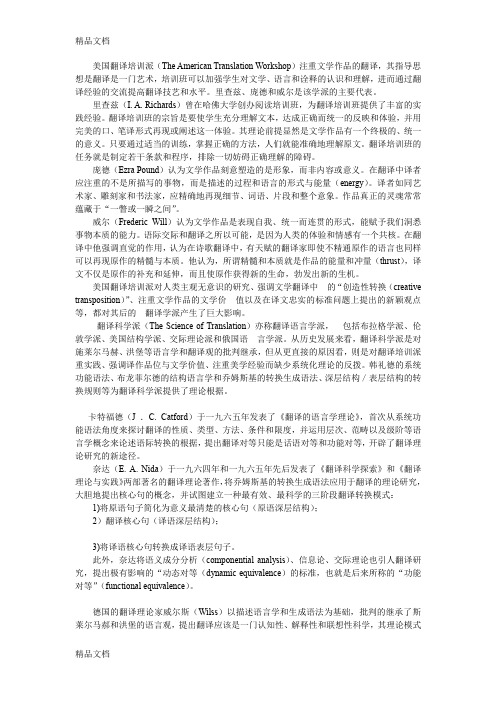
美国翻译培训派(The American Translation Workshop)注重文学作品的翻译,其指导思想是翻译是一门艺术,培训班可以加强学生对文学、语言和诠释的认识和理解,进而通过翻译经验的交流提高翻译技艺和水平。
里查兹、庞德和威尔是该学派的主要代表。
里查兹(I. A. Richards)曾在哈佛大学创办阅读培训班,为翻译培训班提供了丰富的实践经验。
翻译培训班的宗旨是要使学生充分理解文本,达成正确而统一的反映和体验,并用完美的口、笔译形式再现或阐述这一体验。
其理论前提显然是文学作品有一个终极的、统一的意义。
只要通过适当的训练,掌握正确的方法,人们就能准确地理解原文。
翻译培训班的任务就是制定若干条款和程序,排除一切妨碍正确理解的障碍。
庞德(Ezra Pound)认为文学作品刻意塑造的是形象,而非内容或意义。
在翻译中译者应注重的不是所描写的事物,而是描述的过程和语言的形式与能量(energy)。
译者如同艺术家、雕刻家和书法家,应精确地再现细节、词语、片段和整个意象。
作品真正的灵魂常常蕴藏于“一瞥或一瞬之间”。
威尔(Frederic Will)认为文学作品是表现自我、统一而连贯的形式,能赋予我们洞悉事物本质的能力。
语际交际和翻译之所以可能,是因为人类的体验和情感有一个共核。
在翻译中他强调直觉的作用,认为在诗歌翻译中,有天赋的翻译家即使不精通原作的语言也同样可以再现原作的精髓与本质。
他认为,所谓精髓和本质就是作品的能量和冲量(thrust),译文不仅是原作的补充和延伸,而且使原作获得新的生命,勃发出新的生机。
美国翻译培训派对人类主观无意识的研究、强调文学翻译中的“创造性转换(creative transposition)”、注重文学作品的文学价值以及在译文忠实的标准问题上提出的新颖观点等,都对其后的翻译学派产生了巨大影响。
翻译科学派(The Science of Translation)亦称翻译语言学派,包括布拉格学派、伦敦学派、美国结构学派、交际理论派和俄国语言学派。
当代翻译理论(根茨勒)——中文笔记
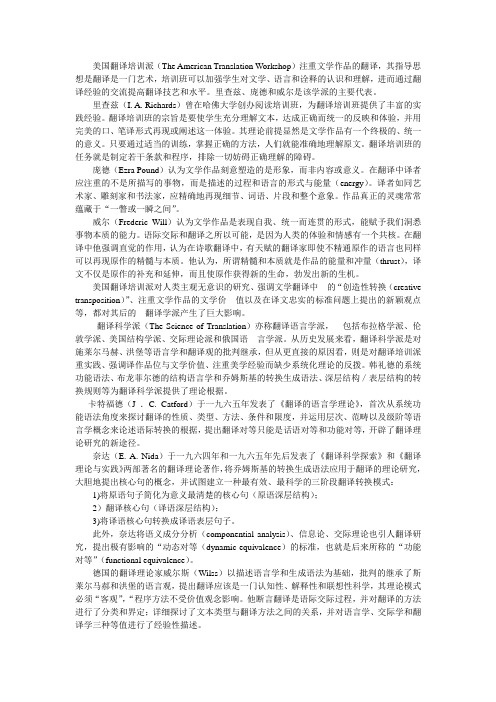
美国翻译培训派(The American Translation Workshop)注重文学作品的翻译,其指导思想是翻译是一门艺术,培训班可以加强学生对文学、语言和诠释的认识和理解,进而通过翻译经验的交流提高翻译技艺和水平。
里查兹、庞德和威尔是该学派的主要代表。
里查兹(I. A. Richards)曾在哈佛大学创办阅读培训班,为翻译培训班提供了丰富的实践经验。
翻译培训班的宗旨是要使学生充分理解文本,达成正确而统一的反映和体验,并用完美的口、笔译形式再现或阐述这一体验。
其理论前提显然是文学作品有一个终极的、统一的意义。
只要通过适当的训练,掌握正确的方法,人们就能准确地理解原文。
翻译培训班的任务就是制定若干条款和程序,排除一切妨碍正确理解的障碍。
庞德(Ezra Pound)认为文学作品刻意塑造的是形象,而非内容或意义。
在翻译中译者应注重的不是所描写的事物,而是描述的过程和语言的形式与能量(energy)。
译者如同艺术家、雕刻家和书法家,应精确地再现细节、词语、片段和整个意象。
作品真正的灵魂常常蕴藏于“一瞥或一瞬之间”。
威尔(Frederic Will)认为文学作品是表现自我、统一而连贯的形式,能赋予我们洞悉事物本质的能力。
语际交际和翻译之所以可能,是因为人类的体验和情感有一个共核。
在翻译中他强调直觉的作用,认为在诗歌翻译中,有天赋的翻译家即使不精通原作的语言也同样可以再现原作的精髓与本质。
他认为,所谓精髓和本质就是作品的能量和冲量(thrust),译文不仅是原作的补充和延伸,而且使原作获得新的生命,勃发出新的生机。
美国翻译培训派对人类主观无意识的研究、强调文学翻译中的“创造性转换(creative transposition)”、注重文学作品的文学价值以及在译文忠实的标准问题上提出的新颖观点等,都对其后的翻译学派产生了巨大影响。
翻译科学派(The Science of Translation)亦称翻译语言学派,包括布拉格学派、伦敦学派、美国结构学派、交际理论派和俄国语言学派。
第四章 当代西方翻译理论
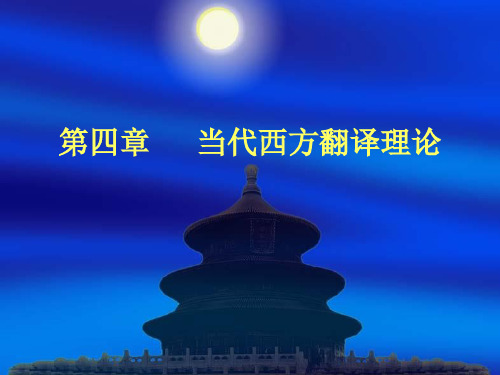
威密尔则突破了对等理论的限制 ,以文本目的(skopos)为翻译过程的第 一准则 ,发展了功能派的主要理论:目的论(skopos theory) 。威密尔所提 出的目的论(skopos theory)是功能派翻译理论中最重要的理论。skopos 是希腊词 ,意思是 “目的” 。根据目的论 ,所有翻译遵循的首要法则 就是 “目的法则” :翻译行为所要达到的目的决定整个翻译行为的过 程 ,即结果决定方法。这个目的有三种解释:译者的目的;译文的交际 目的;和使用某种特殊翻译手段所要达到的目的。通常情况下 , “目的” 是指译文的交际目的。
德国功能主义流派
二十世纪七十年代 ,德国出现一派翻译理论 — —功能派翻
译理论。功能派认为翻译(包括口、 笔译)是一种行为。其 理论的重点表现在三方面: (1)对翻译实质的阐释(2)对翻译 过程参与者的角色分析(3)功能翻译原则的提出。
谈到功能派,就不得不提及三位功能派翻译理论杰出的贡献
20世纪20年代起,前苏联的文学翻译得到发展的同时,翻
译研究也得到长足的进展。其最大特点就是一开始就和文 学翻译紧密联系在一起,但这时还是注重翻译作品的艺术 性。文艺学派开始于当时的俄国形式主义,代表人物为蒂 尼亚诺夫。
楚柯夫斯基的《崇高的艺术》一书问世后,被视为前苏联
译坛文艺学派的代表作之一,此书立足于大量丰富的翻译 实践,探讨了使翻译作品成为真正的艺术作品的途径。
纽马克在《翻译问题探讨》出版,立刻引起广泛赞誉。正
是在这本书中,他提出了“语义翻译”和交际翻译的概念。 此后,分别于1993年何1995年,又出版了《翻译短评》 (Paragraphs on Translation)和《翻译短评(第二集)》 (More paragraphs on Translation)。 翻译试图在译人语的语义和句法结构允许的范围内传达原 著的确切上下文意义。交际翻译试图对译文读者产生一种 效果 ,这效果要尽可能接近原文对读者所产生的效果。 语义翻译的服务对象是原语作者,交际翻译服务的对象是 译入语的读者 。这两种方法的一个根本区别在于:当出现 矛盾时,交际翻译必须强调“ 表现力” ,而不强调信息 的内容。
中国当代翻译理论

许渊冲 对雅赋予了新的含义 《翻译的标准》1981
常谢枫 信达雅是一个提法上混乱,实践上有害的原则 只有一个:信
文学翻译标准
学者们以极大的热情接受,介绍西方翻译理论,以奈达的理论为主
中国译论摆脱了经验主义的束缚,进入了新的时期
许渊冲 江西南昌人 1921-
北京大学教授 著名翻译家
从事文学翻译六十余年,译作涵盖中、英、 法等语种
“文学翻译的最高标准是“化”。把作品从一国文字转 变成另一国文字,既能不因语文习惯的差异而露出生硬 牵强的痕迹,又能完全保存原有的风味,那就算得入与 “化境”。十七世纪有人赞美这种造诣的翻译,比为原 作的“投胎转世(the transmigration of souls )”,
躯壳换了一个,而精神资质依然故我。”
出版社 上海骆驼出版社 三联书店出版 三联书店出版 平民出版社 平民出版社 平民出版社 人民文学出版社 人民文学出版社 人民文学出版社 湖南人民出版社 人民文学出版社 人民文学出版社 人民文学出版社 人民文学出版社 人民文学出版社 人民文学出版社 人民文学出版社 平民出版社 商务印书馆 商务印书馆 商务印书馆 人民文学出版社 人民文学出版社 人民文学出版社
中国翻译理论的流派,根植于中国传统文论和古典美学,可概括为“古典 文论学派 ”
围绕如何和原作相似的角度来探讨翻译,以归化翻译为主
缺乏可操作性:具有神秘主义色彩
翻译理论研究不系统:研究对象相对狭窄,经验式的随笔文章特征明显
对信达雅进行了进一步探究
刘重徳 信,达,切 1979 信于内容 达如其分 切合原文风格
90进入了一个总结和反思的时期
不再热衷于介绍奈达 纽马克 巴尔胡达罗夫等
刘宓庆认为:这是新事物发展的必经阶段,一个有起,有落,有波, 有折的过程
当代国外翻译理论导读
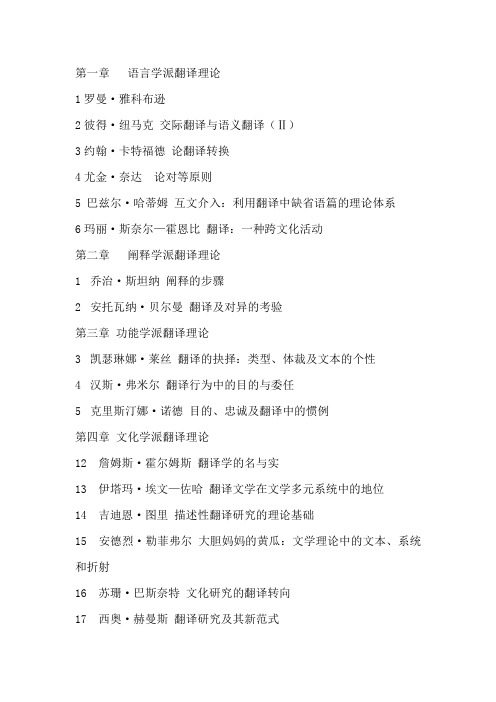
1罗曼·雅科布逊2彼得·纽马克交际翻译与语义翻译(Ⅱ)3约翰·卡特福德论翻译转换4尤金·奈达论对等原则5 巴兹尔·哈蒂姆互文介入:利用翻译中缺省语篇的理论体系6玛丽·斯奈尔—霍恩比翻译:一种跨文化活动第二章阐释学派翻译理论1乔治·斯坦纳阐释的步骤2安托瓦纳·贝尔曼翻译及对异的考验第三章功能学派翻译理论3凯瑟琳娜·莱丝翻译的抉择:类型、体裁及文本的个性4汉斯·弗米尔翻译行为中的目的与委任5克里斯汀娜·诺德目的、忠诚及翻译中的惯例第四章文化学派翻译理论12 詹姆斯·霍尔姆斯翻译学的名与实13 伊塔玛·埃文—佐哈翻译文学在文学多元系统中的地位14 吉迪恩·图里描述性翻译研究的理论基础15 安德烈·勒菲弗尔大胆妈妈的黄瓜:文学理论中的文本、系统和折射16 苏珊·巴斯奈特文化研究的翻译转向17 西奥·赫曼斯翻译研究及其新范式18 瓦尔特·本雅明译者的任务19 雅克·德里达巴别塔之旅20.保罗·德曼评本雅明的《译者的任务》21.劳伦斯·韦努蒂文化身份的塑造第六章女性主义翻译理论22.雪莉·西蒙翻译理论中的性别化立场23.劳丽·钱伯伦性别与翻译的隐喻24.巴巴拉·格达德女性主义话语/翻译的理论化25.冯·弗罗托女性主义翻译理论批评第七章后殖民翻译理论26.道格拉斯·罗宾逊后殖民研究与翻译研究27.特佳斯维妮·尼南贾纳翻译的定位28.盖亚特里·斯皮瓦克翻译的政治29.埃尔斯·维埃拉解放卡利班们——论食人说与哈罗德·德·坎波斯的超越/越界性创造诗学第八章苏东学派翻译理论30.安德烈·费奥多罗夫翻译理论的任务31.吉维·加切奇拉泽文学翻译中的创造性原则32.吉里·列维翻译是一个作选择的过程33.安娜·丽洛娃翻译研究的范畴6Roman Jakobson论翻译的语言学问题“On Linguistic Aspectsof Translation”布拉格语言学派创始人罗曼·雅科布逊1959年发表的《论翻译的语言学问题》首先将语言学、符号学引进了翻译学,他把语言分为“语内翻译(Intralingual Translation)、语际翻译(Interlingual Translation) 和符际翻译(Intersemiotic Translation)”(三分法理论)。
翻译理论研究之四——当代西方翻译理论流派评述翻译科学派

翻译理论研究之四——当代西方翻译理论流派评述翻译
科学派
中文翻译科学派是当代西方中文翻译理论的一个重要流派,主要关注翻译的科学性和规范性。
该流派强调翻译是一种科学的活动,需要通过系统的方法和理论来进行研究和实践。
中文翻译科学派的主要代表人物有吴立言、邱立本、孙振威、韦沛然等。
他们在研究中文翻译理论方面,采取了基于现代语言学和翻译学的方法,强调翻译必须建立在对原文和译文语言本质的准确理解基础上。
中文翻译科学派的研究重点包括翻译的原则、策略、方法和技巧等方面。
他们认为翻译必须遵循一定的原则,如忠实原文、准确传达信息、灵活运用语言等。
此外,他们还注重研究翻译的具体方法和技巧,如句法结构分析、语义转换、文化背景的考虑等。
中文翻译科学派的研究成果为当代中文翻译理论的发展做出了重要贡献。
他们的研究方法和理论对翻译教学和实践也具有指导作用。
同时,中文翻译科学派的研究还促进了中西方翻译理论交流和学科建设的发展。
总之,中文翻译科学派是当代西方中文翻译理论的一支重要流派,以科学性和规范性为特点。
他们的研究对中文翻译的理论和实践具有重要的指导意义。
翻译学 第三章 当代西方翻译理论
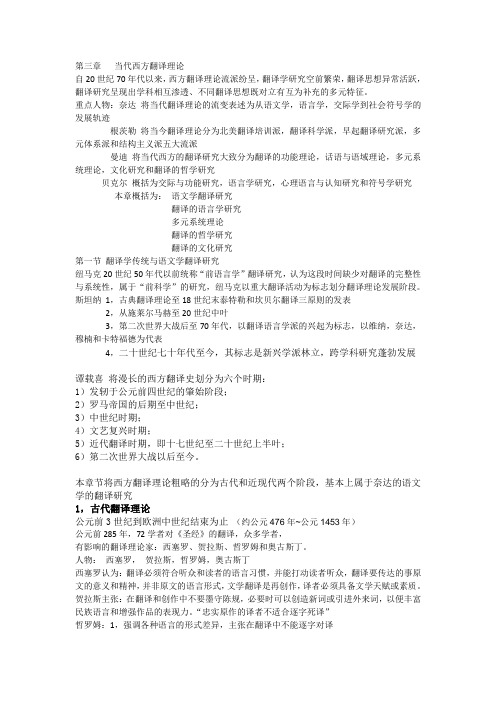
第三章当代西方翻译理论自20世纪70年代以来,西方翻译理论流派纷呈,翻译学研究空前繁荣,翻译思想异常活跃,翻译研究呈现出学科相互渗透、不同翻译思想既对立有互为补充的多元特征。
重点人物:奈达将当代翻译理论的流变表述为从语文学,语言学,交际学到社会符号学的发展轨迹根茨勒将当今翻译理论分为北美翻译培训派,翻译科学派,早起翻译研究派,多元体系派和结构主义派五大流派曼迪将当代西方的翻译研究大致分为翻译的功能理论,话语与语域理论,多元系统理论,文化研究和翻译的哲学研究贝克尔概括为交际与功能研究,语言学研究,心理语言与认知研究和符号学研究本章概括为:语文学翻译研究翻译的语言学研究多元系统理论翻译的哲学研究翻译的文化研究第一节翻译学传统与语文学翻译研究纽马克20世纪50年代以前统称“前语言学”翻译研究,认为这段时间缺少对翻译的完整性与系统性,属于“前科学”的研究,纽马克以重大翻译活动为标志划分翻译理论发展阶段。
斯坦纳1,古典翻译理论至18世纪末泰特勒和坎贝尔翻译三原则的发表2,从施莱尔马赫至20世纪中叶3,第二次世界大战后至70年代,以翻译语言学派的兴起为标志,以维纳,奈达,穆楠和卡特福德为代表4,二十世纪七十年代至今,其标志是新兴学派林立,跨学科研究蓬勃发展谭载喜将漫长的西方翻译史划分为六个时期:1)发轫于公元前四世纪的肇始阶段;2)罗马帝国的后期至中世纪;3)中世纪时期;4)文艺复兴时期;5)近代翻译时期,即十七世纪至二十世纪上半叶;6)第二次世界大战以后至今。
本章节将西方翻译理论粗略的分为古代和近现代两个阶段,基本上属于奈达的语文学的翻译研究1,古代翻译理论公元前3世纪到欧洲中世纪结束为止(约公元476年~公元1453年)公元前285年,72学者对《圣经》的翻译,众多学者,有影响的翻译理论家:西塞罗、贺拉斯、哲罗姆和奥古斯丁。
人物:西塞罗,贺拉斯,哲罗姆,奥古斯丁西塞罗认为:翻译必须符合听众和读者的语言习惯,并能打动读者听众,翻译要传达的事原文的意义和精神,并非原文的语言形式,文学翻译是再创作,译者必须具备文学天赋或素质。
当代翻译理论:翻译科学派

理论来源—转换生成语法
❖According to Chomsky, the phrase structure rules represent the internalized and unconscious workings of the human mind; deep structure determines meaning underlying sentence; and surface structure determines sound. p 48
evangelical (conversion experiences, reliance on Scripture, and missionary work ) Christian belief (and an anti-intellectual stance) that the word should be accessible to all. p 46
14
沃尔夫兰·威尔斯 ❖ 威尔斯是德国萨尔大学的语言学和翻译教授,专
门从事口、笔译人才的培养。他的研究侧重于翻 译的宏观理论,他的主要译学思想体现在专著《 翻译学的问题与方法》一书中。该书反映了他在 两个问题上的观点:翻译是科学;翻译应以语篇 为单位。
15
威尔斯的研究领域
❖ 普通翻译学、涉及两种具体语言的特指翻译学、应用翻译学 ❖ “General science” is heavily weighted toward text-linguistic
威尔斯的翻译理论
❖ 《翻译学的问题与方法》 ❖ He concludes that translation is possible because
the hermeneutic process gives us access to these universals and the generative potential of the universals enables language to transcend specific social and cultural boundaries. ❖ He excitedly concludes that “the ‘generative’ reserves of this potential are so great as to enable a speech community to adequately cover any and all extralinguistic states of affairs, including those beyond the scope of their own sociocultural experience”.
(翻译概论教学课件)第四章当代西方翻译理论

¡ 意大利美学家、文学评论家克罗齐在《美学原理》提出了完全相等于 原作表达方式的翻译不可能存在, 翻译必须靠再创造。文学翻译不 可过分自由、专业翻译不可过分拘谨的观点, 他是从美学的角度谈 翻译的。
¡ 西奥多·萨瓦里的翻译理论主要在《翻译的艺术》, 这被誉为“英语 中论述翻译的最佳之作”。他指出, 翻译是一门艺术。他把文学翻 译比作绘画, 把科技翻译比作摄影。将翻译分为完美翻译、等值翻 译、综合翻译、科技翻译四种。完美的翻译即纯粹传递信息的翻译, 等值翻译是不拘形式, 只管内容的翻译, 科技翻译的特点与等值翻 译有相似之处, 因为在科技翻译中, 内容的重要性远超过语言表达 形式的重要性。他归纳了12条准则指导翻译实践。。
第四章 当代西方翻译理论
¡ 英国翻译学家纽马克将西方研究翻译的历史划分为两大时期: 从公元前55年到20世纪上半叶属于语言学前时期, 20世纪 下半叶则属语言学时期。美国语言学家兼圣经翻译家奈达则 认为西方的翻译理论有四大流派: 语文学派、语言学派、交 际学派和社会符号学派。语言学前时期主要翻译圣经和文学 作品,翻译主要是少数人的事,这个时期的翻译理论就是奈 达所说的语文学派的理论。后三种理论流派即纽马克所说的 语言学时期的翻译理论。
¡ 奈达认为,一般意义上翻译过程包括以下几个阶段: 分析、转 移和重
组(analysis, transfer, and reconstruct),即首先 分析原作语言的息,将其剖析成结构上最简单明了的形式,在 此基础上转移,然后再
当代翻译理论试题及答案
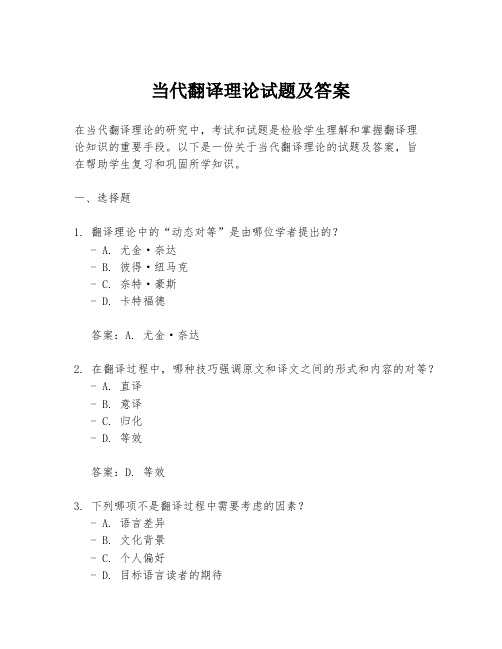
当代翻译理论试题及答案在当代翻译理论的研究中,考试和试题是检验学生理解和掌握翻译理论知识的重要手段。
以下是一份关于当代翻译理论的试题及答案,旨在帮助学生复习和巩固所学知识。
一、选择题1. 翻译理论中的“动态对等”是由哪位学者提出的?- A. 尤金·奈达- B. 彼得·纽马克- C. 奈特·豪斯- D. 卡特福德答案:A. 尤金·奈达2. 在翻译过程中,哪种技巧强调原文和译文之间的形式和内容的对等? - A. 直译- B. 意译- C. 归化- D. 等效答案:D. 等效3. 下列哪项不是翻译过程中需要考虑的因素?- A. 语言差异- B. 文化背景- C. 个人偏好- D. 目标语言读者的期待答案:C. 个人偏好二、简答题1. 简述尤金·奈达的“功能对等”理论。
答案:尤金·奈达的“功能对等”理论,也称为“动态对等”,强调翻译应该使目标语言读者能够与原文本的读者有相同的反应。
这种理论认为,翻译不仅仅是语言的转换,更是文化和情感的传递。
翻译者需要考虑目标语言的文化背景和读者的预期,以达到功能上的对等。
2. 描述彼得·纽马克的语义翻译和交际翻译的区别。
答案:彼得·纽马克区分了语义翻译和交际翻译两种策略。
语义翻译侧重于传达原文的字面意义,而交际翻译则侧重于传达原文的功能和效果。
语义翻译更多地保留原文的语言特点,而交际翻译则更多地适应目标语言的语言习惯和文化背景。
三、论述题1. 论述翻译中的文化适应性问题,并给出实例。
答案:在翻译过程中,文化适应性是一个复杂的问题。
翻译者需要在保持原文文化特色的同时,使译文适应目标语言的文化环境。
例如,将中文成语“塞翁失马,焉知非福”翻译成英文时,如果直接翻译可能不易被英语读者理解。
因此,翻译者可能会选择一个文化上更接近的表达,如“Every cloud has a silver lining”,以此来传达相同的寓意。
中国当代著名翻译家及其观点-文档资料
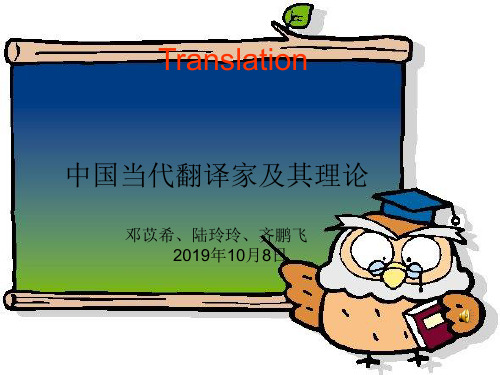
纵使大海干涸水流尽, 太阳将岩石烧作灰尘, 亲爱的,我永远爱你, 只要我一息犹存。
许渊冲(1921-)他的译诗融意美、音美和形美为一体,
在实践中实施自己的三美主张。 译作:《诗经》、《楚辞》、《唐诗三百首》等
(一)"三美论"(意美、音美、形美)是译诗的本体论。
意美不仅要表达原作的字间之意,还要传达原作的言外之意; 音美即重视原文的音韵和节奏; 形美就是要再现原作的长短、对仗、重复等形式方面的特征。
(三)强调译文 “气息贯通——文脉贯通”。傅雷认为,如果意 脉不贯,“句句断,节节断,”支离破碎,全篇真的就会变成一 个徒具形式而拼凑内容的“散”文了。 例: Mettre qqn. au bord du tombeau 直译:这种痛苦的病将我置于坟墓的边缘 在规范化汉语中,这样的句子读起来不通顺 傅雷译文:这种痛苦的病,有时候几乎把我命都送掉
Translation
中国当代翻译家及其理论
邓苡希、陆玲玲、齐鹏飞 2019年10月8日
当代翻译(新中国成立以后)
• 新中国成立初期:环境特殊、“一边倒” 苏联著作 • “文革”时期:翻译、出版领域, 基本上成 为一片荒漠 • 改革开放以来:翻译 出版事业蓬勃发展,形 成中国翻译史上又一次(第四次)翻译高 潮。
Hale Waihona Puke 我的爱人像朵红红的玫瑰王佐良 译
Till a' the seas gang dry, my dear, And the rocks melt wi' the sun; And I will luve thee still , my dear, While the sands o' life shall run.
(三)提倡将文体学和翻译研究结合起来。
根茨勒的_当代翻译理论_第二版_评介_李江春
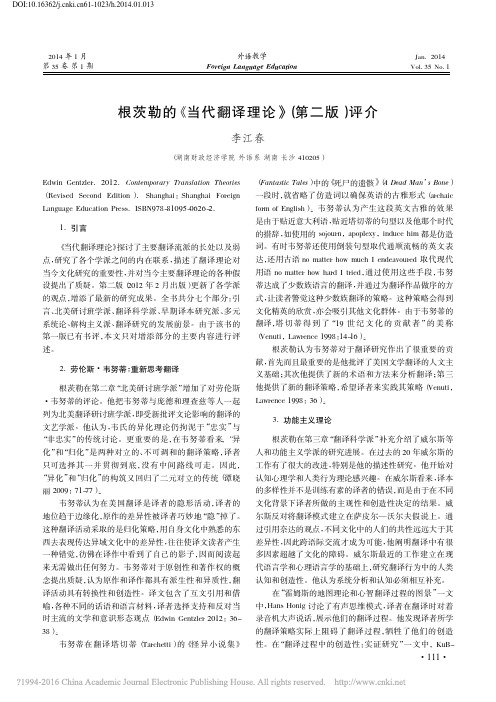
2014年1月第35卷第1期外语教学Foreign Language EducationJan.2014Vol.35No.1根茨勒的《当代翻译理论》(第二版)评介李江春(湖南财政经济学院外语系湖南长沙410205)Edwin Gentzler.2012.Contemporary Translation Theories (Revised Second Edition).Shanghai:Shanghai Foreign Language Education Press.ISBN978-81095-0626-2.1.引言《当代翻译理论》探讨了主要翻译流派的长处以及弱点,研究了各个学派之间的内在联系,描述了翻译理论对当今文化研究的重要性,并对当今主要翻译理论的各种假设提出了质疑。
第二版(2012年2月出版)更新了各学派的观点,增添了最新的研究成果。
全书共分七个部分:引言、北美研讨班学派、翻译科学派、早期译本研究派、多元系统论、解构主义派、翻译研究的发展前景。
由于该书的第一版已有书评,本文只对增添部分的主要内容进行评述。
2.劳伦斯·韦努蒂:重新思考翻译根茨勒在第二章“北美研讨班学派”增加了对劳伦斯·韦努蒂的评论。
他把韦努蒂与庞德和理查兹等人一起列为北美翻译研讨班学派,即受新批评文论影响的翻译的文艺学派。
他认为,韦氏的异化理论仍拘泥于“忠实”与“非忠实”的传统讨论。
更重要的是,在韦努蒂看来,“异化”和“归化”是两种对立的、不可调和的翻译策略,译者只可选择其一并贯彻到底,没有中间路线可走。
因此,“异化”和“归化”的构筑又回归了二元对立的传统(谭晓丽2009:71-77)。
韦努蒂认为在美国翻译是译者的隐形活动,译者的地位趋于边缘化,原作的差异性被译者巧妙地“隐”掉了。
这种翻译活动采取的是归化策略,用自身文化中熟悉的东西去表现传达异域文化中的差异性,往往使译文读者产生一种错觉,彷佛在译作中看到了自己的影子,因而阅读起来无需做出任何努力。
当代翻译理论(根茨勒)――中文笔记
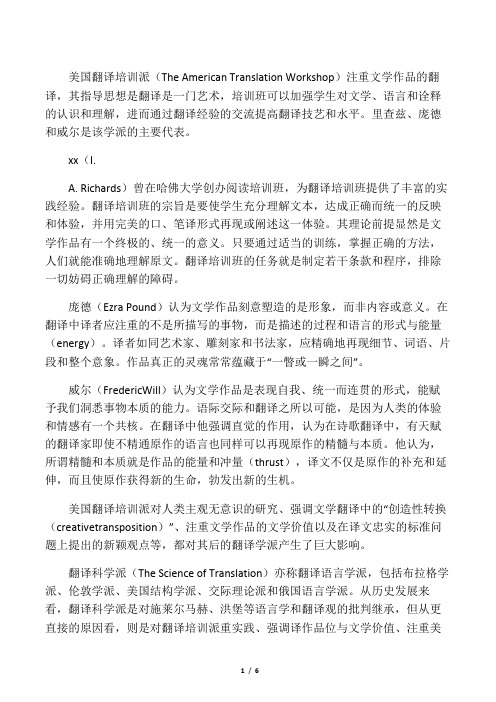
美国翻译培训派(The American Translation Workshop)注重文学作品的翻译,其指导思想是翻译是一门艺术,培训班可以加强学生对文学、语言和诠释的认识和理解,进而通过翻译经验的交流提高翻译技艺和水平。
里查兹、庞德和威尔是该学派的主要代表。
xx(I.A. Richards)曾在哈佛大学创办阅读培训班,为翻译培训班提供了丰富的实践经验。
翻译培训班的宗旨是要使学生充分理解文本,达成正确而统一的反映和体验,并用完美的口、笔译形式再现或阐述这一体验。
其理论前提显然是文学作品有一个终极的、统一的意义。
只要通过适当的训练,掌握正确的方法,人们就能准确地理解原文。
翻译培训班的任务就是制定若干条款和程序,排除一切妨碍正确理解的障碍。
庞德(Ezra Pound)认为文学作品刻意塑造的是形象,而非内容或意义。
在翻译中译者应注重的不是所描写的事物,而是描述的过程和语言的形式与能量(energy)。
译者如同艺术家、雕刻家和书法家,应精确地再现细节、词语、片段和整个意象。
作品真正的灵魂常常蕴藏于“一瞥或一瞬之间”。
威尔(FredericWill)认为文学作品是表现自我、统一而连贯的形式,能赋予我们洞悉事物本质的能力。
语际交际和翻译之所以可能,是因为人类的体验和情感有一个共核。
在翻译中他强调直觉的作用,认为在诗歌翻译中,有天赋的翻译家即使不精通原作的语言也同样可以再现原作的精髓与本质。
他认为,所谓精髓和本质就是作品的能量和冲量(thrust),译文不仅是原作的补充和延伸,而且使原作获得新的生命,勃发出新的生机。
美国翻译培训派对人类主观无意识的研究、强调文学翻译中的“创造性转换(creativetransposition)”、注重文学作品的文学价值以及在译文忠实的标准问题上提出的新颖观点等,都对其后的翻译学派产生了巨大影响。
翻译科学派(The Science of Translation)亦称翻译语言学派,包括布拉格学派、伦敦学派、美国结构学派、交际理论派和俄国语言学派。
《当代翻译理论》埃德温.根次勒

《当代翻译理论》埃德温.根次勒Contemporary translation theoriesBy Edwin Gentzler 1 The North American Translation WorkshopIn many academic circles in North America, literary translation is still considered secondary activity, mechanical rather than creative, neither worthy of serious critical attention nor of general interest to the public. Translators, too, frequently lament the fact that there is no market foe their work and that what does get published is immediately relegated to the margins of academic investigation. Yet, a closer analysis of the developments over the last four decades reveals that in some circles literary translation has been drawing increasing public and academic interest.In the early sixties, there were no translation workshops at institutions of higher learning in the United States. Translation was a marginal activity at best, not considered by academia as a proper field of study in the university system. In his essay "The State of Translation, " Edmund Keeley, director of translation workshops first at Iowa and later at Princeton, wrote," In 1963 there was no established and continuing public forum for the purpose: no translation centres, no associations of literary translator as far as know, no publications devoted primarily to translations, translators, and their continuing problems"(keeley, 1981:11). In this environment, Paul Engle, Director of the Writers' Workshop at the University of Iowa, gave the first heave; arguing that creative writing knows no national boundaries, he expanded the Creative Writing Program to include international writers. In 1964 Engle hires a full-time director for what was the firsttranslation workshop in the United Stated and began offering academic credit for literary translations. The following year the Ford Foundation conferred a $150,000 grant on the University of Texas at Austin toward the establishment of the National Translation Center. Also in 1965, the first issue of Modern Poetry in Translation, edited by Ted Hughes and Daniel Weissbort, was published, providing literary translators a place for their creative work. In 1968, the National Translation Center published the first issue of Delos, a journal devoted to the history as well as the aesthetics of translation had established a place, albeit a small one, in the production of American culture.The process of growth and acceptance continued in the seventies. Soon translation coursesand workshops were being offered at several universities-Yale, Princeton, Columbia, Iowa, Texas, and State University of New York, Binghamton among them. Advanced degrees were conferred upon students for creative, historical, and theoretical work in the field of literary translation. This, in turn, led to the establishment of the professional organization American Literary Translators Association(ALTA) in the late seventies as well as the founding of the journal Translation for that organization. By 1977, the United States government lent its authority to this process with the establishment of the National Endowment of the Humanities grants specifically for literary translation. For a while in the late seventies and early eighties, it looked as if the translation workshop would follow the path of creative writing, also considered at one time a non-academic field, and soon be offered at as many schools as had writing workshops.But despite the increase in translation activity and its gaining of limited institutional support in the sixties and seventies, theprocess of growth plateaued. Many assumptions about the secondary status of the field remained. T oday, while many universities offer advanced degrees in creative writing, comparatively few offer academic credit for literary translation. One reason is surely the monolinguistic nature of the culture. Howerer, such typecasting is also due to socio-economic motives: labeling translations as derivative serves to reinforce an existing status quo, one that places primary emphasis not on the process but on the pursuit and consumption of "original" meaning. The activity of translation represents a process antithetical to certain reigning literary beliefs, hence its relegation to marginal status within educational and economic institutions and its position in this society as part of a counter-cultural movement.Indeed, during the sixties and early seventies, the practice of literary translation became heavily in representations of alternate value systems and views of reality. While not taken seriously by academics, sales of translated literary texts enjoyed unprecedented highs on the open market. Perhaps no one articulated the political urgency and popular attraction of literary translations during this period better than Ted Huges: That boom in the popular sales of translated modern poetry was without precedent. Though it reflected only one aspect of the wave of mingled energies that galvanized those years with such extremes, it was fed by almost all of them-Buddhism, the mass craze of Hippie ideology, the revolt of the young, the Pop music of the Beatles and their generation... That historical moment might well be seen as...an unfolding from inwards, a millennial change in the IndustrialWest's view of reality. (Hughes. 1983:9)For Hughes, the translation boom of the sixties was simplyone aspect of a generational movement that articulated itself in a variety of media. While his view of translation as anti-establish may not have been true of all translation during this period, it did hold true for a large and influential group of contemporary American poets actively translating at the time: Zdynas's notes seem characteristic of prevailing assumptions regarding the teaching of translation in the United States. He shares the assumption that creative writing cannot be taught, that creative talent is something one is born with. Such a belief plagued creative writing for years before it was accepted as an university discipline. Secondly, Zdanys reveals a prejudice for teaching students how to enjoy the original poem, one that is in keeping with New Critical tenets. His conclusion is not altogether surprising-although he argues against conventional wisdom that translation can be taught at the university, he does it not for reasons Ted Hughes suggested-that it may lead to a change in the West views reality-but because it reinforces a fairly conservative humanistic ideology. This is nowhere better revealed than in a contradiction within the essay regarding the theoretical basis of the course. On the one hand, Zdynas hopes the course will attract students interested in theoretical question; on the other hand, he argues that he himself opposes the restraints of "predetermined aesthetic theories." in addition, without telling us why, Zdanys says that "this essay unfortunately cannot consider" the contribution of deconstruction to the field. Although, ironically, Yale itself houses numerous such critics who are in fact part of the same department (a special interdepartmental program) in which the course was offered.Zdanys clearly finds translation a subjective activity, subsuming translation under the larger goal of interpretingliterature. His argument that the study of translation can lead to a qualitative "richer" understanding reveals the humanistic agenda. His goal is more clearly disclosed in a section of the same essay in which he talks about the presence of a female linguistics students who, despite Zdany's "initial misgivings" about what she might contribute to the seminar, actually brought a "valuable and intriguing" perspective to the aesthetic process he was teaching. Zdanyd contradicts his stated premise-a rejection of predetermined aesthetic theories-when he concludes that although her approach was a "refreshing" addition to the course, he "secretly hopes" that he "converted" her during the course. The lingering question is "converted her to what?"Zdynas's notes seem characteristic of prevailing assumptions regarding the teaching of translation in the United States. He shares the assumption that creative writing cannot be taught, that creative talent is something one is born with. Such a belief plagued creative writing for years before it was accepted as an university discipline. Secondly, Zdanys reveals a prejudice for teaching students how to enjoy the original poem, one that is in keeping with New Critical tenets. His conclusion is not altogether surprising-although he argues against conventional wisdom that translation can be taught at the university, he does it not for reason Ted Hughes suggested- that it may lead to a change in the way the West views reality- but because it reinforces a fairy conservative humanistic ideology. This is nowhere better revealed than in a contradiction within the essay regarding the theoretical basis of the course. On the one hand, Zdynas hopes the course will attract students interested in theoretical; on the hand, he argue that he himself opposes the restraints of "predetermined aesthetic theories." In addition, without tellingus why, Zdanys says that "this essay unfortunately cannot consider" the contrition of deconstruction to the field, although, ironically, Yale itself houses numerous such critics who are in fact part of the same department (a special interdepartmental program) in which the course was offered.Zdanys clearly finds translation a subjective activity, subsuming translation under the larger goal of interpreting literature. His argument that the study of translation can lead to a qualitative "richer" understanding reveals the humanistic agenda. His goal is more clearly disclosed in a section of the same essay in which he talks about the presence of a female linguistics student who, despite Zdanys's "initial misgivings" about what she might contribute to the seminar, actually brought a "valuable and intriguing" perspective to the aesthetic process he was teaching. Zdanys contradicts his stated premise-a rejection of predetermined aesthetic theories-when he concludes that although her approach was a "refreshing" addition to the course, he "secretly hopes" that he "converted" her during the course. The lingering question is "converted her to what?"That unarticulated "what" is the topic I wish to address in this chapter. Scholars associated with the North American translation workshop premise tend to claim that their approach is not theoretically preconditioned; this chapter attempts to formulate the non-dit present in their works, to analyze those underlying assumptions, and to show how they either reinforce the existing literary edifices or offer a counterclaim that deserves further consideration. Through thisapproach, I hope to show that the translation workshop approach actually does both, i.e., simultaneously reinforces and subverts, and that this dual activity, necessarily operative becauseof the methodology, is in itself a contribution to the ongoing investigation of not only translation phenomena, but of language in general.2 Frederic Will: The paradox of translationWhile Richards's work in translation might be charactererized as an extension of his literary criticism, Frederic Will's literary theory- initially not unlike Richards's- has changed much because of his involvement in translation. Will's work in translation theory is symptomatic of that of many adherents of the American workshop approach. Will first taught Classics at the University of Texas, where he founded the journal Arion with William Arrowsmith. He then moved to the forefront in translation by accepting the directorship of the translation workshop at the University of Iowa in 1964. In 1965, he founded Micromegas, a journal devoted to literary translation, each issue focused on the poetry of a different country. His first theoretical text Litersture Inside Out, published in 1966, raised questions about naming and meaning and indirectly suggests that translation can be viewed as a form of naming, fiction-making, and knowing(Will,1966:15). His next book, The Knife in the Stone, published in 1973, dealt directly with the practice of translation; and parts of it rearticulated his workshop experience at Iowa.Although Will's early text did not specifically address translation problems, certain relevant theoretical assumptions are visible. Will's project picks up where Richards's left off: he uses New Critical beliefs to try to reconcile recent critical theories. Will's first essay "From Naming to Fiction Making" in Literature Inside Out appears to agree with a theory of cultural relativism. Holding that different languages construct separate realities and that what any particular word refers to cannot be determinedprecisely,Will calls into question translation theories based on reference to a universal objective reality. Reality can only be learned, he argues, through the names we give it, and so , to a certain degree, language is the creator of reality. Will also distances himself from theories that posit a notion of univeral themes or motifs, theories which do not view symbol-making as part of a human activity. At the same time, however, Will argues that knowledge of essence is possible:"The core of the self, the theme of its efforts, is love," which is a power unto itself and can bring the outer reality"into the focus of consciousness"(Will,1966:9). Naming, for Will, is the fundamental activity of man-without thepower to name we would have remained savages. Language, thus, he argues, takes on our character, out rhythm, our desires, and reveals our true inner selves. Will continues to say that The self's effort, in naming, is not mere verbal play but is part of its overall effort to translate the outer into the human. This situation follows from the unity of the self. In such unity the expression of a core-movement, the self, all bear the character of that movement. Each expression bears the core's character.(Will,1966:13 )As opposed to an objective outer reality that can be translated across cultures, Will posits a central common core of human experience and emotions that can overcome the indeterminate nature of language and bring that "outer reality" into focus. We translate our selves into language; naming does not necessarily give us any insight regarding outside reality(that to which language refers), but it does help us to better know our inner selves.The power of this inner understanding and knowledge isfurther elaborated in the second essay, "Literature and Knowledge," in which the influence of Richards is everywhere to be seen. Literature, according to Will, also "embodies truth and knowledge" (1966: 17). The New Critical tenet of the unity of the original text is also adopted; Will argues that a work of literature "is a deeply unified verbal event occurring in a self." the words that compose a work of literature, so important to Pound, are merged with the whole for Will, and "are, in some sense, literally one." in the literary work, "most or all" of the levels of meaning of words, and Will lists five-dictionary, contextual, symbolic, interpretative, and inner aural and visual overtones- "are made one" (Will, 1966:18). Will's agenda, like Richards' s, is fundamentally didactic, not just in terms of developing competent literary critics, but also in terms of a larger, humanistic goal. Literature, according to Will not only "gives us the power to understand," but also serves as a means to understand a higher metaphysical power. Will clearly believes that "that power to understand something is 'knowledge' of something." Yet we have seen that Will is skeptical about our ability to know objective reality. He concludes with the rhetorical question, "Will else can knowledge be, even about the natural world or about God, except the power to understand them?" (Will, 1966; 2 4 ). Literary works present us with models by which we can "clarify" the real, irrational world that we experience as a "confusion of intermingled space, action, and character." literature thus deepens and enriches our lives as well as gives us a better understanding of our own true selves.Will then reexamines his own theory after his experience in the translation workshop at theUniversity of Iowa and after have after having read Pound.Although his next theoretical text, The Knife in the Stone, retain metaphysical concepts, many of his romantic notion of love and humanistic believes in the power of the heart dissipate. His concept of text becomes less of a unified and coherent whole; instead it is seen as being interwoven with reality, subject to use, change, and variable interpretations. In The Knife in the Stone, Will uses translation as the "testing ground" for his theory, and clearly the goal is to substantiate the metaphysical beliefs he brings to the project: The inter-translatibility of languages is the firmest testing ground, and demonstration ground, for the existence of a single ideal body of literature. If there is any meaning, to the ideal of such a body, it will show itself through as effort to equate literature in one language with literature in another,(Will,1973;42)Again, the opposition includes those who are skeptical about the possibility of translation, those who question concepts of literariness, and those who find the concept of referentiality problematic. Will names Sartre and Mead, whose theories posit inner "selves" who are not ware of the universal core of human experience, but are, in Will's terminology, "groundless" and "social constructed" respectively. Though the test of translation, Will intends disprove the "relativity" thesis and show that one universal common ground-that of the single ideal body of literature-does, in fact, enjoy "inter-translatibility". However, Will's argument, when put to the test, dose not confirm his initial presuppositions, but causes him to alter his conception of translation in a manner that may be of interest to contemporary theory.The change in the logic of Will's argument is most apparent in the final essay of The Knife in the stone, called paradoxically"Faithful Traitor", a play on the Italian aphorism tradutore, traditore. Briefly, the article reviews his experience teaching at Iowa. In the course of the activity of actual translation, it became clear to Will that what he was translating had less to do with the meaning of the text and more with the energy of the expression, how meaning was expressed in language. He found himself using a kind of Poundian theory. The cultural relativity thesis that once was so problematical is adapted by turning it back in on itself, not to oppose his practice, but to contribute as an equally always present part. Since language is indeterminate, since we never have access to be the meaning behind specific language, all the more reason to be free and trust not what language says but what the language does. The traditional notion of translation to fall into categories of "faulty equivalences" and of "versions" of the original. What Willadvocates instead is an approach that translates not what a work meaning, but the energy or "thrust" of a work, for which there is no "correct" way of translating.翻译研究20世纪70年代末,一条新的学术原则诞生,那就是翻译研究。
第二讲当代翻译理论
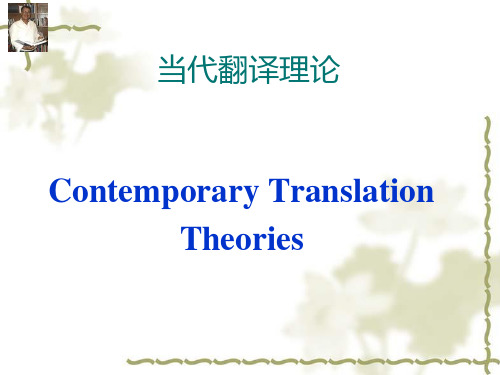
2.3 Horace
Horace argues for the revitalization of well-known texts through a style that would “neither linger in the one hackneyed and easy round; neither trouble to render word by word with the faithfulness of a translator”, not treat the original writer‟s beliefs with too easy a trust, and would avoid stylistic over-sensationalism, “ so that the middle never strikes a different note from the beginning, nor the end from the middle.” His criticism of the faithful translator is often turned on its head to support translational fidelity to the original.
3.4.1 John Dryden‟s Three Categories of Translation 3.5 Alexander Fraser Tytler ( 1747-1813) 3.5.1 Tytler‟s Three General Principles
4. Romanticism in Translation Studies
another language
- 1、下载文档前请自行甄别文档内容的完整性,平台不提供额外的编辑、内容补充、找答案等附加服务。
- 2、"仅部分预览"的文档,不可在线预览部分如存在完整性等问题,可反馈申请退款(可完整预览的文档不适用该条件!)。
- 3、如文档侵犯您的权益,请联系客服反馈,我们会尽快为您处理(人工客服工作时间:9:00-18:30)。
名词解释:
1、文化转向轮:是翻译研究两大主将勒菲弗尔和巴斯内特共同提出的,即翻
译研究所要关注的不仅仅是语言问题,它必须在更广阔的历史文化视野中
展开自己的讨论。
2、归化翻译:是要把源语本土化,以目标语或译文读者为归宿,采取目标语
读者所习惯的表达方式来传达原文的内容。
归化翻译要求译者向目的语的
读者靠拢,译者必须像本国作者那样说话,原作者要想和读者直接对话,译作必须变成地道的本国语言。
归化翻译有助于读者更好地理解译文,增
强译文的可读性和欣赏性。
3、异化翻译:是“译者尽可能不去打扰作者,让读者向作者靠拢”。
在翻译
上就是迁就外来文化的语言特点,吸纳外语表达方式,要求译者向作者靠
拢,采取相应于作者所使用的源语表达方式,来传达原文的内容,即以目
的语文化为归宿。
使用异化策略的目的在于考虑民族文化的差异性、保存
和反映异域民族特征和语言风格特色,为译文读者保留异国情调。
4、功能对等论:所谓“功能对等”,就是说翻译时不求文字表面的死板对应,
而要在两种语言间达成功能上的对等。
奈达提出对等包括四个方面:1. 词
汇对等,2. 句法对等,3. 篇章对等,4. 文体对等。
在这四个方面中,“意
义是最重要的,形式其次”。
5、功能目的论:目的论认为,所有翻译活动遵循的首要原则是“目的原则”,
即翻译应能在译入语情境和文化中,按译入语接受者期待的方式发生作用。
翻译行为所要达到的目的决定整个翻译行为的过程,即结果决定方法。
但
翻译活动可以有多个目的,这些目的进一步划分为三类:(1)译者的基本
目的(如谋生);(2)译文的交际目的(如启迪读者);(3)使用某种特殊的翻
译手段所要达到的目的(如为了说明某种语言中的语法结构的特殊之处采
用按其结构直译的方式)。
但是,通常情况下,“目的”指的是译文的交际
目的,即“译文在译人语社会文化语境中对译入语读者产生的交际功能”。
(Venuti:2001)因此,译者应在给定的翻译语境中明确其特定目的,并根
据这一目的来决定采用何种翻译方法—直译、意译或介于两者之间。
6、不可译性理论:英语属于印欧语系,而汉语属于汉藏语系,其语音系统,
文字结构和修辞方法都完全不同,这些绝大多数都无法在另一语言中找到
对等语。
如果在英汉互译中,有时无法将原语或源语(source language)
翻译成译入语或目的语(target language)而造成一定程度上意义的损失,即称为“不可译性”。
它包括“语言上的不可译(linguistic untranslatability )”
和“文化上的不可译(cultural untranslatability)”。
7、女性主义翻译观:否定传统的摹仿论,主张翻译是文化介入和文化协调;
否定对原文高贵、译文卑贱的等级观念,提出原文译文的共生关系,否定单一和绝对的意义,强调意义的丰富性和差异;并对翻译的标准以及译者的创造性提出独到的见解。
其主要观点包括:
(1)对传统翻译理论标准“忠实”的颠覆,强调叛逆
中外传统翻译理论一直把“忠实”视为翻译的根本准则之一。
传统翻译理论中翻译标准的核心就是“信”或“忠实”,译文必须忠实于原作,以原作/作者为中心,强调译文/译者对原作/作者的绝对忠实。
女性主义翻译理论家们坚决反对这一观点,她们认为,语言中充满了性别歧视,“忠实”通常意味着剥夺女性的话语权(马丽娜, 2012, p.127)。
因此,在翻译中,她们要“妇弄”(woman handling)文本,对文本从女性视角、以女性的方法进行操纵,大胆实践自己的理论宗旨。
(2)重新界定译文与原作的关系,突显译者主体性
女性主义翻译理论打破了传统的“作者/原作-译者/译文”的两元对立模式,提倡原作-译文的共生共荣。
这首先表现在翻译延伸了原作的生命,使得它得以在另一个语言文化空间中面对新的读者群体。
也就是本雅明所说的译文是原作的后续的生命 (afterlife),译文为原作开启了一个更加广阔的生存空间。
女性主义翻译理论家们提出“性别译者”(feminist translator)的概念,首先肯定了译者性别差异所导致的对原文文本意义阐释过程中的不同,从而丰富了原文文本的内涵;同时也提高了译者的主体性并肯定了译者在翻译过程中的创造性。
长久以来,传统翻译理论以“忠实”和“等值”为基础,忽视了译者的主体性。
译文一直被认为是原作的附庸,译着仅仅是派生的和非创造性的活动,把译者的主体性化为零,是原作之镜。
但女性主义者从译者的性别角色入手,重新界定了译文与原作的关系,突显了译者的主体性。
(3)消除翻译语言中的性别歧视
除了理论上的贡献外,女性主义翻译理论家们进行了大量丰富的翻译实践,以消除翻译语言中的性别歧视。
尤其是对《圣经》作女性主义及两性兼容的语言( inclusive-language) 的阐释引发了争论,不仅让人们注意到性别化语言带来的冲突性的含义,而且也加强了对人们对翻译作为内容丰富的阐释活动的理解。
她们宣称,在翻译过程中要用各种翻译策略彰显女性在文本中的地位,让女性的声音在语言中“可见”。
在翻译的实践中,很多女性主义译者大胆采用新词、新拼法、新语法结构,以及运用一些文字游戏,目的在于超越男权语言的成规,为女性话语开辟新空间。
8、假朋友:是指在语义结构上相似或相同,但含义却不相同的词或句子结构。
I haven’t slept better.我睡得好极了。
It can’t be less in teresting.它无聊极了。
Black tea红茶而非黑茶
9、翻译悖论:。
